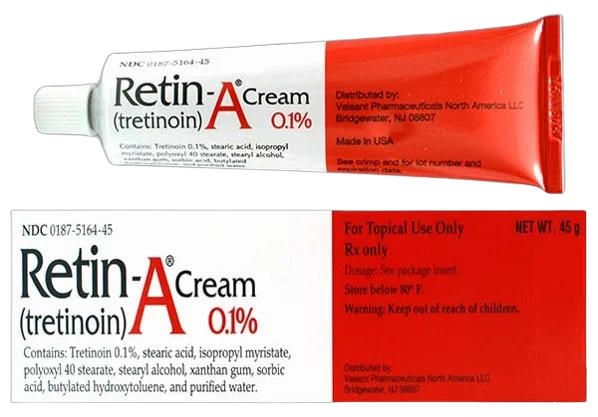Tretinoin boosts collagen synthesis, improving skin elasticity and reducing wrinkles and fine lines. It improves skin texture and promotes smoother, firmer skin by accelerating skin renewal. It fades age spots and reduces hyperpigmentation and sun-induced dark spots. It is effective for hyperpigmentation and melisma. Generic Retin A 0.1% evens skin tone by reducing melanin overproduction, making it a key ingredient for treating dark spots, post-inflammatory hyperpigmentation (PIH), and melisma. The high potency (0.1% Strength) concentration is an advanced treatment of persistent acne, severe photoaging, stubborn dark spots, or discoloration. Scientifically Backed and FDA-Approved, Tretinoin has decades of clinical research.
What is Generic Retin A Cream (Tretinoin) 0.1%?
Its mechanism of action focuses on improving skin cell turnover and modulating skin processes to deliver healthier and rejuvenated skin.
Mechanism of Action
Increases Skin Cell Turnover
Tretinoin stimulates the skin’s natural process of shedding old, dead cells and replacing them with new, healthy cells. It helps to unclog pores, prevent and treat acne, smoothen rough skin texture, Promoting fresher, more radiant skin.
Prevents Acne Formation
By preventing the buildup of dead skin cells, Tretinoin reduces the chance of pore blockage, a leading cause of blackheads, whiteheads, and inflammatory acne lesions. It minimizes the formation of new acne.
Stimulates Collagen Production
Generic Retin A (Tretinoin) induces collagen production, a protein responsible for skin elasticity and firmness. It reduces fine lines, wrinkles, and skin sagging over time, leading to smoother and firmer skin.
Reduces Hyperpigmentation
Generic Retin A (Tretinoin) slows down the overproduction of melanin, the pigment responsible for dark spots and discoloration. It helps fade sunspots, age spots, and post-inflammatory hyperpigmentation (e.g., from acne scars). It evens out skin tone for a brighter complexion.
Modulates Sebum Production
Generic Retin A (Tretinoin) regulates oil (sebum) production by skin glands, reducing excessive oiliness, a common cause of acne.
Exfoliates Dead Skin Cells
By promoting faster shedding of dead skin, Generic Retin A (Tretinoin) keeps skin clear and free of debris that can contribute to clogged pores and dullness.
Repairs Photo-Damage
Generic Retin A (Tretinoin) works to reverse damage caused by UV radiation, such as fine lines, uneven texture, and pigmentation issues. It promotes the development of healthier skin layers.
What are the Uses and Benefits of Generic Retin A Cream 0.1%?
Uses of Generic Retin A (Tretinoin) 0.1%
Acne Treatment
- It reduces blackheads, whiteheads, and inflammatory acne lesions.
- It prevents clogged pores by promoting cell turnover.
- Controls excess oil production, minimizing acne recurrence.
Anti-Aging Therapy
- Reduces the appearance of fine lines and wrinkles by stimulating collagen production.
- It improves skin elasticity and firmness.
- Smoothens rough skin texture, giving a youthful look.
Hyperpigmentation and Discoloration
- It treats uneven skin tone, dark spots, and sunspots.
- It helps fade post-inflammatory hyperpigmentation (e.g., acne scars).
- Reduces melasma by regulating melanin production.
Photoaging (Sun Damage)
Generic Retin A Cream repairs damage caused by prolonged UV exposure, such as leathery texture, pigmentation, and loss of elasticity.
Skin Texture and Tone Improvement
- It enhances skin smoothness and clarity.
- It promotes a radiant complexion.
Keratosis Pilaris and Other Skin Conditions
Generic Retin A Cream helps manage rough skin conditions by exfoliating dead skin and promoting regeneration.
Benefits of Tretinoin 0.1%
Clinically Proven Efficacy
Tretinoin is a dermatologist-trusted treatment backed by decades of research addressing acne, aging, and pigmentation concerns.
Multifunctional Treatment
Generic Retin A Cream targets multiple skin issues, making it a versatile addition to skincare routines.
Stimulates Natural Skin Renewal
Accelerates cell turnover to replace damaged skin with healthier, rejuvenated cells.
Prevents Future Skin Issues
- Reduces clogged pores and regulates oil production, preventing new acne breakouts.
- It protects against the progression of fine lines and wrinkles.
Boosts Collagen Production
Generic Retin A Cream improves skin elasticity, reducing sagging and giving the skin a firmer appearance.
Brightens Complexion
Generic Retin A Cream helps achieve an even skin tone by fading discoloration and promoting healthy skin renewal. Regular use leads to sustainable improvements in overall skin health, including texture, tone, and clarity.
Non-Invasive Option
Generic Retin A Cream offers significant skin improvement with no surgical or more invasive cosmetic procedures.
What are the Safe Dosages of (Tretinoin) Generic Retin A Cream 0.1%?
The dosage of Tretinoin (Generic Retin A) 0.1% refers to how much and how often you should apply it to achieve optimal results while minimizing potential side effects. Tretinoin is available as a cream, gel, or solution.
Standard Dosage Instructions
Initial Application
A small amount (pea-sized) is sufficient for the entire face.
For localized areas (e.g., acne spots or pigmentation), apply a thin layer only to the affected areas. Start once every 2-3 nights to allow your skin to adjust. Gradually increase to once daily or as tolerated.
Steps for Application
- Cleanse the Skin
- Wash your face with a mild cleanser and pat it dry.
- Ensure your skin is completely dry before applying Tretinoin to minimize irritation.
- Apply a Thin Layer
- Spread a pea-sized amount evenly over your face or affected areas.
- Avoid Sensitive Areas
- Do not apply to the eyes, lips, nostrils, or any broken or irritated skin.
Factors Affecting Dosage Frequency
Skin Sensitivity
Individuals with sensitive skin may need to limit use to 2-3 times per week until their skin adapts.
Severity of Skin Concern
For severe acne or hyperpigmentation, your dermatologist may recommend more frequent applications.
Moisturizer Use
Applying a moisturizer before or after Generic Retin A Cream (Tretinoin) can help reduce dryness and irritation without affecting its efficacy.
Duration of Use
It may take 6-12 weeks to see noticeable improvements. Long-term use (6+ months) provides the most significant and lasting benefits. Continue usage even if acne clears or skin improves to maintain results. Applying more than the recommended amount will not speed up results but can increase irritation, redness, and peeling. Not typically for children under 12 unless a dermatologist directs.
Sun Protection
Always use sunscreen (SPF 30 or higher) during the day, as Tretinoin increases photosensitivity.
How to Apply Generic Retin A Cream (Tretinoin) 0.1%?
- Cleanse Your Skin
- Wash your face with a gentle, non-drying cleanser to remove dirt, oil, and makeup.
- Pat your skin dry with a soft towel. Ensure it is dry before applying Tretinoin.
- (Wait 10-15 minutes if your skin feels damp, as applying to wet skin can increase irritation.)
- Take a Small Amount
Squeeze a pea-sized amount of Tretinoin onto your fingertip. A small amount is sufficient for the entire face. Overusing it can cause unnecessary irritation.
- Apply Thinly and Evenly
Dab small dots of the cream or gel onto key areas of your face (e.g., forehead, cheeks, chin, and nose). Gently spread the product evenly across your face using your fingertips. Avoid rubbing harshly—use light, upward motions.
- Avoid Sensitive Areas
Do not apply Tretinoin to:
- The corners of your mouth
- Eyes or eyelids
- Nostrils
- Broken, irritated, or sunburned skin
- If accidental application occurs, gently wipe it off with a damp cloth.
- Follow with Moisturizer (Optional)
If your skin is dry or sensitive to irritation, wait 20-30 minutes after applying Generic Retin A Cream (Tretinoin), then apply a non-comedogenic moisturizer. Alternatively, apply moisturizer before Tretinoin to buffer its strength if you are new to using it.
- Use at Night
Apply Generic Retin A Cream (Tretinoin) in the evening as part of your nighttime skincare routine. Avoid applying it during the day because Tretinoin increases sensitivity to sunlight.
- Sun Protection is Crucial
Generic Retin A Cream increases skin photosensitivity. Apply a broad-spectrum sunscreen (SPF 30 or higher) daily, even on cloudy days. Wear protective clothing and avoid prolonged sun exposure.
Patience is Key
It may take 6–12 weeks to see noticeable improvements. Temporary redness, peeling, or dryness is normal as your skin adjusts. Refrain from using other exfoliants (e.g., scrubs, AHAs, or BHAs) unless a dermatologist advice. Avoid alcohol-based toners or astringents that may worsen irritation. Apply Generic Retin A Cream (Tretinoin) regularly as prescribed by your dermatologist to achieve the best results.
When Should I Avoid Generic Retin A Cream 0.1% (Tretinoin) or Use it cautiously?
When to Avoid Tretinoin 0.1%
Pregnancy and Breastfeeding
Avoid use unless prescribed by a doctor. Exercise caution while breastfeeding, as the effects on infants are not well-studied.
Severely Irritated or Sunburned Skin
Do not apply Retin A to skin that is:
- Sunburned
- Wind burned
- Broken or raw
- Extremely dry or irritated
Eczema or Other Skin Conditions
Avoid applying Generic Retin A Cream to areas affected by eczema, as it may worsen irritation.
Allergic Reactions
Do not use it if you are allergic to Generic Retin A Cream (Tretinoin) or any other ingredients in the formulation.
Skin Infections
Avoid applying Generic Retin A Cream to areas with active skin infections (e.g., herpes simplex, impetigo), as it may exacerbate the condition.
Concurrent Use of Photosensitizing Medications
Avoid if you are taking medications that increase skin sensitivity to sunlight, such as:
- Tetracyclines
- Fluoroquinolones
- Sulfonamides
Severe Weather Exposure
Prolonged exposure to extreme cold or wind can increase irritation when using Tretinoin.
When to Use Tretinoin 0.1% Cautiously
Sensitive Skin
People with sensitive skin may experience increased irritation, redness, or peeling. Start with a lower concentration (e.g., 0.025%) or apply less frequently until your skin adapts.
Initial Breakout Phase
Generic Retin A Cream may cause an initial purge where acne worsens before it improves. It is temporary and usually resolves within a few weeks.
Sun Exposure
Generic Retin A Cream increases photosensitivity:
- Avoid direct sunlight and tanning beds.
- Use broad-spectrum sunscreen (SPF 30 or higher) daily.
Concurrent Use of Other Skincare Products
Avoid using products that contain:
- Alcohol
- Alpha-hydroxy acids (AHAs)
- Beta-hydroxy acids (BHAs)
- Benzoyl peroxide
- Harsh exfoliants
These can exacerbate irritation.
Dehydrated or Dry Skin
Use a gentle, non-comedogenic moisturizer to prevent dryness or peeling.
Gradual Introduction
Begin by applying Generic Retin A Cream every other night to allow your skin to adjust and increase the use as tolerated.
What are the Side effects of Generic Retin A Cream (Tretinoin) 0.1%?
Common (Tretinoin) Generic Retin A Cream 0.1% Side Effects
- Skin Irritation
- Dryness and Peeling
- Increased Sensitivity
- Temporary Acne Flare-Up (Purging)
- Itching or Tightness
- Mild Discomfort
Severe (Tretinoin) Generic Retin A Cream 0.1% Side Effects
- Severe Skin Irritation
- Allergic Reactions (Hypersensitivity)
- Excessive Dryness or Cracking
- Photosensitivity Reactions
- Skin Infection or Worsening Acne
- Discoloration of Skin
- Eye or Mucous Membrane Irritation




